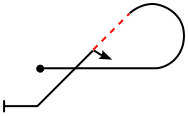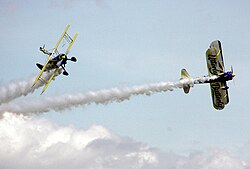Benutzer Diskussion:Red Rooster/Werkstatt/Kunstflug Manöver
Welche deutschen Artikel gibt's schon?[Quelltext bearbeiten]
Gehört zu den Aresti-Symbolen[Quelltext bearbeiten]
Most of these can be entered either erect or inverted, flown backwards or have extra rolls added.
Where appropriate, the Aresti Catalog symbols have been included. Not all the figures are competition figures, and so some do not have diagrams to accompany the description.
Reading the diagrams, a figure is flown from end with the solid circle to the end with the line. Inverted flight (negative g) is depicted by dashed red lines.
Zerteilung der Tabelle[Quelltext bearbeiten]
| Name des Figur | Beschreibung | Aresti-Symbol |
|---|---|---|
| Chandelle | ||
| Chandelle, Wing-over | Es wird eine 180°-Kurve mit gleichbleibender Gasstellung geflogen, in der das größtmögliche Steigen für die jeweilige Eingangsgeschwindigkeit erzielt werden soll. Diese Figur erzeugt nur geringe, positive G-Kräfte und kann mit allen Flugzeugen geflogen werden. | (Keine Wettbewerbsfigur) |
| Name des Figur | Beschreibung | Aresti-Symbol |
|---|---|---|
| Cuban Eight | ||
| Kubanische Acht |
|
 |
| Halbe kubanische Acht |
|
 |
| Rückwärts geflogene, halbe kubanische Acht |
|
 |
Gehört zu den Aresti-Symbolen[Quelltext bearbeiten]
Most of these can be entered either erect or inverted, flown backwards or have extra rolls added.
Where appropriate, the Aresti Catalog symbols have been included. Not all the figures are competition figures, and so some do not have diagrams to accompany the description.
Reading the diagrams, a figure is flown from end with the solid circle to the end with the line. Inverted flight (negative g) is depicted by dashed red lines.
| Figur | Beschreibung | Aresti-Symbol |
|---|---|---|
| Turn; Stall Turn | ||
| Turn; Stall Turn | 1/4 loop (pull or push) to vertical, as momentum/airspeed decreases, rudder is applied and the aircraft rotates around its yaw axis, the nose falls through the horizon and points towards the ground, a momentary pause is made to draw the vertical down line, and 1/4 loop to level flight. This figure is sometimes called a stall turn which is a misnomer because the aircraft never actually stalls. The manoeuvre is performed when the aeroplane decelerates through 20 - 30kts (more or less, depending on the aeroplane flown) of airspeed. The cartwheel portion of the hammerhead is performed with full rudder and full opposite aileron. Gyroscopic forces from the propeller during the rapid rate of yaw will produce a pitching and rolling moment and a degree of forward stick will be required to keep the aeroplane from coming off-line over the top. The yaw is stopped with opposite rudder while the ailerons and elevator remain in position, then once the yaw is stopped and the aeroplane is pointed down vertically, all controls are returned to neutral together. Although they can be flown left or right in any aeroplane with the proper technique, a hammerhead is best flown to the left with a clockwise rotating prop, and to the right with an anticlockwise rotating prop (as in a Yakovlev type), due to propeller torque/gyroscopic effects. |  |
| Immelmann; Roll-off-the-top; Split S | ||
| Immelmann; Immelmann turn; Roll-off-the-top; half loop, half roll | 1/2 looping up followed by half a roll. There should be no pause between the end of the looping section and the start of the roll to erect flight. |  |
| Split S | Essentially an Immelmann in reverse. Half roll (from erect to inverted) followed by positive pitch to give a half loop. Converts altitude to airspeed, and reverses direction. |  |
| Up lines | ||
| Vertical up | Fly the aircraft so that the fuselage is perpendicular to the ground (along the wings' Zero lift axis.) The flight path is not judged, and therefore the aircraft may drift downwind during a vertical maneuver. |  |
| 45° up line | The object is for the airplane flight path to be 45° from horizontal, as viewed by a ground observer. The actual angle flown when viewed by the pilot would differ depending on whether the figure is flown into or with the wind, and wind strength. |  |
Loop[Quelltext bearbeiten]
| Figur | Beschreibung | Aresti-Symbol |
|---|---|---|
| Looping | ||
| Innenlooping | Der Innenlooping ist ein vertikaler Kreis, der aus dem aufrechten Geradeausflug durch ziehen des Steuerknüppels eingeleitet wird. In jeder Position schaut der Pilot in das innere des Kreises. Beim Innen-Looping herrschen positive G-Kräfte. |  |
| Außenlooping | Der Außenlooping ist ein vertikaler Kreis, der aus dem aufrechten Geradeausflug durch drücken des Steuerknüppels eingeleitet wird. In jeder Position schaut der Pilot nach außen aus dem Kreis heraus. Beim Außen-Looping wirken negative G-Kräfte. |  |
| halber Außenlooping (English bunt) | Der halbe Außenlooping ist fast das Gleiche wir ein voller Außenlooping, nur wird er genau in der hälfte beendet. Dieses Manöver endet mit Rückenflug. |  |
Spin (Trudeln)[Quelltext bearbeiten]
| Figur | Beschreibung | Aresti-Symbol |
|---|---|---|
| Spin | ||
| Erect spin; Inverted spin; Flat spin | A family of auto-rotational maneuvers, consisting of normal or "flat" spins, either upright or inverted. Two components must exist to spin an aircraft: 1) critical angle of attack (COA), which means that the aircraft is stalled, and 2) yaw. |  |
| Tailslide | ||
| Tailslide | 1/4 looping up, straight vertical (full power) until the aircraft loses momentum. The aircraft falls backwards, tail first, until the nose drops through the horizon to a vertical down position. 1/4 loop (push or pull) to recovers to level flight. |  |
| Snap Roll; Flick roll; Flick | ||
| Snap Roll; Flick roll; Flick | A family of rapid autorotational or "horizontal spins," not unlike spins. Rotation is induced by a rapid pitch input followed by rapid yaw input, thus stalling one wing further than the other. This imbalance in lift causes the high speed roll. | |
Somewhat[Quelltext bearbeiten]

